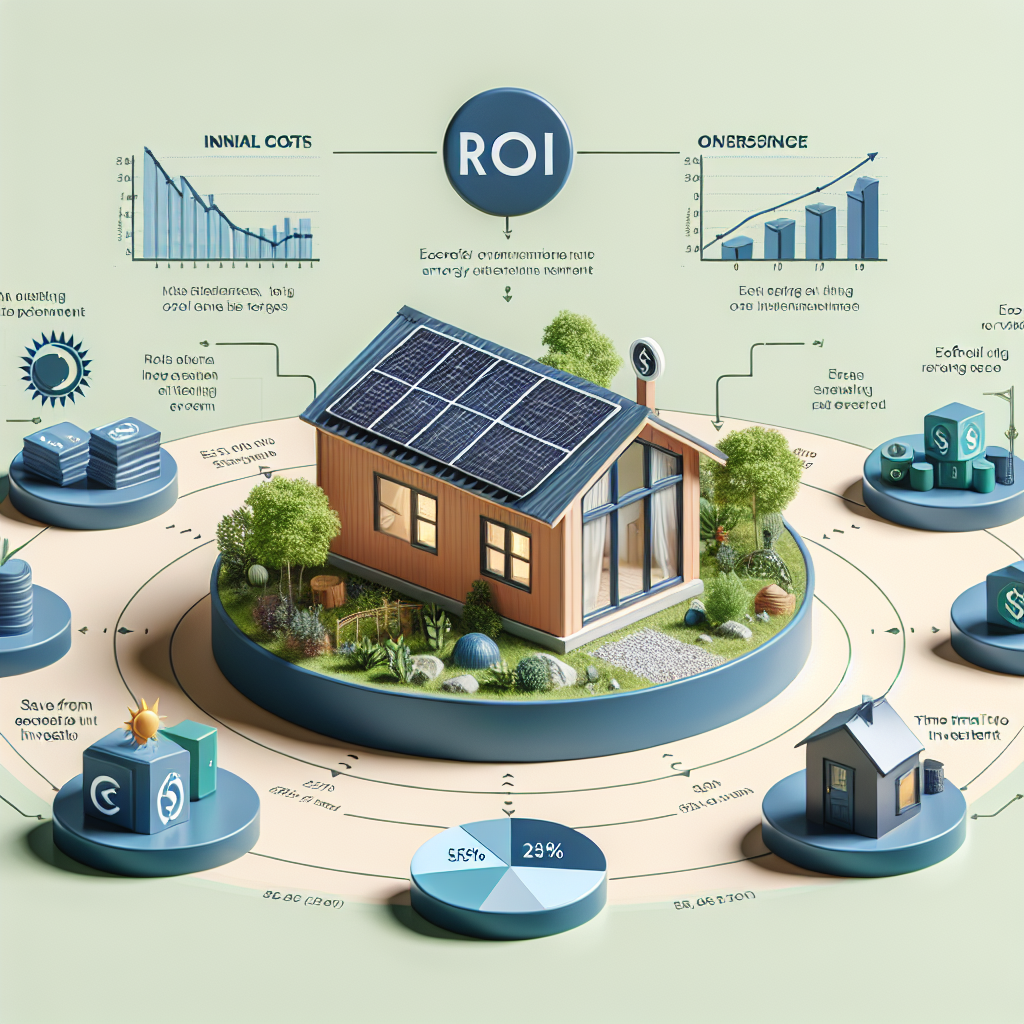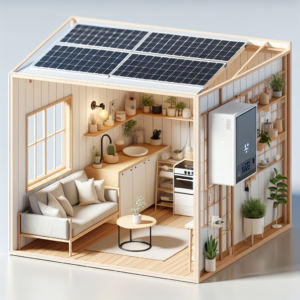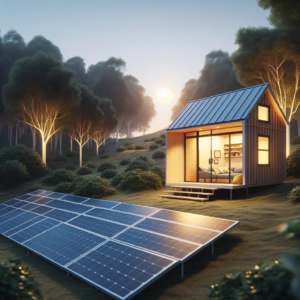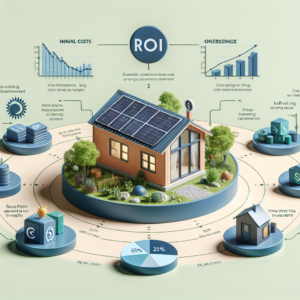
Maximizing Your Tiny Home Energy: EcoFlow Solar Panels
Imagine your tiny home, nestled in nature, powered by the sun. It’s not just a dream; it’s a reality with EcoFlow solar panels. As tiny home enthusiasts, we’re always looking for ways to live more sustainably and efficiently. Harnessing solar energy is a game-changer, and EcoFlow solar panels are at the forefront of this movement. They promise to deliver not just energy, but also savings and independence. Let’s explore if they’re truly worth the investment for your tiny abode.
Understanding Solar Panel ROI
Return on Investment, or ROI, is a key term in the solar panel conversation. It’s all about the bang for your buck. With EcoFlow solar panels, the ROI isn’t just measured in dollars and cents. It’s also about the environmental impact and the freedom from the grid. But let’s get practical: when will the panels pay for themselves, and what will your savings look like? We’ll break down the numbers, from initial costs to long-term benefits, to give you a clear picture of the financial side of solar energy for your tiny home.
Key Factors Influencing Solar Panel Performance
Before you bask in the sun’s glory, let’s consider what affects solar panel performance. Not all tiny homes are created equal, and the same goes for solar setups. Here’s what you need to keep an eye on:
-
Sunlight Exposure – your location dictates the amount of sunshine your panels will soak up
-
Weather Patterns – overcast skies can mean less energy production
-
Panel Placement – the angle and position of your panels can make a huge difference
-
Energy Needs – how much power does your tiny home consume?
-
System Efficiency – not all solar panels are created equal—some convert sunlight to energy more effectively than others
Understanding these factors will help you optimize your solar panel performance and ensure your investment is sound.
EcoFlow Solar Panel Overview

EcoFlow solar panels are more than just a power source; they’re a statement of independence and sustainability. Designed with the latest technology, these panels are crafted to meet the unique needs of tiny home dwellers. But what sets EcoFlow apart from the rest?
Firstly, it’s the ease of installation. EcoFlow has designed their solar panels with the DIY enthusiast in mind. They understand that tiny home owners are hands-on and want a system that they can set up themselves. Secondly, it’s the portability. And if your tiny home is one which moves, EcoFlow solar panels can easily move with you. Lastly, it’s the smart technology. EcoFlow panels are equipped with features that allow you to monitor and control your energy usage right from your smartphone.
But don’t just take my word for it. Let’s dive into the specifics and see how EcoFlow stands up to the needs of your tiny home.
Features and Advantages for Tiny Homes
When you’re living small, every inch and every watt counts. EcoFlow solar panels offer features that make them a perfect fit for tiny homes:
-
Compact Design – these panels are built to fit the limited space on a tiny home’s roof without sacrificing power
-
High Efficiency – with top-tier solar cells, you get more energy from less sunlight
-
Durability – built to withstand the elements, these panels are a long-term investment
-
Smart Monitoring – stay informed about your energy production and consumption with intuitive apps
-
Modular Expansion – as your energy needs grow, so can your solar setup
These features translate to real-world advantages. Less space taken up on your roof means more room for that rooftop deck or garden. High efficiency means you can power your home even during those short winter days. And durability? That means peace of mind, knowing your investment will last.
System Components and Setup
Setting up an EcoFlow solar panel system is like putting together a puzzle designed just for you. You’ve got your solar panels, sure, but there’s more to it. Here’s what you’ll be working with:
-
Solar Panels – the stars of the show, these convert sunlight into electricity
-
Charge Controller – this little device manages the energy flow, protecting your batteries from overcharging
-
Battery Bank – where you’ll store that precious power for when the sun isn’t shining.
-
Inverter -this converts the stored DC power into AC power that your tiny home’s appliances can use
-
Monitoring System – keep tabs on your energy with real-time data
Now, don’t let this list intimidate you. EcoFlow’s systems are designed for ease of installation. With clear instructions and customer support just a call away, you’ll have your tiny home powered by the sun in no time. And the best part? You’ll be saving money and living sustainably while you do it.
EcoFlow vs. Other Solar Options
Now, let’s stack EcoFlow up against the competition. With so many solar options on the market, why choose EcoFlow for your tiny home? To answer that, we need to look at how EcoFlow compares in terms of efficiency, cost, and adaptability to the unique needs of tiny living.
Comparative Analysis with Competitors
Here’s how EcoFlow measures up to other solar panel brands:
-
Efficiency – EcoFlow panels are designed to maximize energy production, even in limited spaces
-
Cost – while not always the cheapest, the value for money is evident in their durability and smart features
-
Flexibility – EcoFlow’s modular design allows for easy expansion as your energy needs grow
-
Portability – for tiny homes on the go, the lightweight and portable design of EcoFlow panels is a big plus
Comparing these factors side by side with other brands, EcoFlow often comes out ahead, especially when you consider the unique demands of tiny home living.
Why EcoFlow Could Be the Best Fit for Your Tiny Home
Choosing the right solar panels for your tiny home is about finding the best match for your lifestyle. EcoFlow stands out for several reasons:
-
User-Friendly: The DIY-friendly design makes setup a breeze, even if you’re not a tech wizard.
-
Smart Tech: EcoFlow’s integration with smart devices means you can monitor and adjust your energy usage on the fly.
-
Space-Efficient: Their compact size doesn’t compromise on power, making them ideal for small roofs.
-
Reliability: With a strong track record and robust build, you can count on EcoFlow panels for consistent energy production.
For tiny home owners, EcoFlow provides a balance of efficiency, innovation, and reliability that can make all the difference. When you choose EcoFlow, you’re not just buying solar panels; you’re investing in a system that’s tailored to the tiny home experience.
Making the Decision
Deciding to invest in solar panels for your tiny home is a big step. It’s not just about today’s needs, but also about planning for a sustainable future. You’ve weighed the pros and cons, crunched the numbers, and imagined the freedom that comes with energy independence. Now, it’s time to decide: Are EcoFlow solar panels the right choice for your tiny home?
Is EcoFlow Right for Your Tiny Home?
Here’s the deal: EcoFlow solar panels are a top contender for tiny homes, but they’re not a one-size-fits-all solution. Consider your lifestyle. Are you stationary or constantly on the move? How much energy do you use daily? Do you have the space and the right conditions for solar panels? If you’re leaning towards a life off the grid, with a focus on sustainability and self-sufficiency, then EcoFlow might just be the perfect match for your tiny home.
Steps to Take for Potential Buyers
If you’re on the brink of going solar with EcoFlow, here’s your action plan:
-
Assess Your Energy Needs: Look at your current energy consumption to determine the size and number of panels you’ll need.
-
Check for Incentives: Research federal, state, and local incentives that could offset your initial costs.
-
Consider Financing Options: Explore loans, leases, and other financing to make the investment more manageable.
-
Choose a Reputable Dealer: Buy from an authorized EcoFlow dealer to ensure you’re getting genuine products and support.
-
Plan Your Installation: Decide whether you’ll DIY or hire professionals to install your panels.
-
Prepare for Maintenance: Understand the maintenance requirements to keep your system running smoothly.
Take these steps, and you’ll be on your way to a successful solar panel installation that can provide clean, renewable energy for years to come.
Key Takeaways
-
EcoFlow solar panels offer a sustainable and efficient energy solution for tiny homes, with a focus on ease of installation and smart technology.
-
ROI for solar panels includes financial savings, environmental impact, and energy independence.
-
Several factors influence solar panel performance, including location, weather patterns, and energy needs.
-
Long-term benefits like tax incentives and increased home value can enhance the overall ROI of your solar panel investment.
-
Before making the decision, assess your specific needs and consider all the steps involved in transitioning to solar power.
FAQ
What is the average ROI for solar panels in tiny homes?
The average ROI for solar panels in tiny homes can vary widely, but here’s the scoop: Most tiny home owners begin to see a return on their investment within 5 to 10 years. This timeframe can be shorter if you qualify for tax credits, rebates, or incentives. The exact ROI depends on factors like your energy consumption, the cost of your system, and how much you save on utility bills. Remember, the benefits aren’t just monetary; they also include reducing your carbon footprint and increasing your energy independence.
How do I calculate the ROI for my EcoFlow Solar Panel setup?
To calculate the ROI for your EcoFlow Solar Panel setup, you’ll need to consider both the costs and the savings. Here’s a simple way to get started:
-
Calculate Total Costs: Add up the cost of the solar panels, installation, additional equipment, and any permits or inspections.
-
Estimate Your Savings: Determine how much electricity you’ll generate and multiply that by your current electricity rate to find out how much you’ll save each month.
-
Factor in Incentives: Subtract any tax credits or rebates you receive from the total costs.
-
Calculate Payback Period: Divide the adjusted total costs by your estimated monthly savings to find out how many months it will take to break even.
-
Consider Long-Term Savings: After the payback period, the savings go directly into your pocket, not to mention the potential increase in your home’s value.
Remember, the longer you have your solar panels, the more you save, and the greater your ROI will be.
What incentives might affect the ROI of EcoFlow Solar Panels?
Incentives can significantly improve the ROI of your EcoFlow Solar Panels. Here’s what to look out for:
-
Federal Solar Investment Tax Credit (ITC): You can reduce your federal tax liability by a significant percentage of your solar panel system cost.
-
State Tax Credits: Many states offer additional tax credits, further decreasing your upfront costs.
-
Rebates: Some utilities and local governments offer rebates that can provide immediate savings.
-
Net Metering: If your system produces more energy than you use, you can sell it back to the grid in some areas, earning credits on your electric bill.
-
Solar Renewable Energy Certificates (SRECs): In certain states, you can earn and sell SRECs for producing solar energy, which can be a significant source of income.
These incentives can dramatically reduce your initial investment and shorten the payback period, so make sure to research what’s available in your area.
How does geographical location affect solar panel efficiency?
Your geographical location plays a critical role in the efficiency of your solar panels. Here’s why:
-
Sunlight Intensity: Areas closer to the equator typically receive more intense sunlight, which can increase solar panel output.
-
Day Length: Longer days in summer can lead to more hours of sunlight and more energy production.
-
Weather Patterns: Regions with frequent overcast days or high levels of precipitation may see reduced solar efficiency.
-
Temperature: Solar panels operate most efficiently in moderate temperatures; extreme heat can actually reduce their performance.
By understanding how your location affects solar efficiency, you can better estimate the energy output of your panels and the potential ROI.
Can EcoFlow Solar Panels increase the resale value of my tiny home?
Yes, EcoFlow Solar Panels can increase the resale value of your tiny home. Here’s what makes them appealing to potential buyers:
-
Energy Independence: The ability to generate your own electricity is a huge selling point for those looking to live off-grid or reduce their carbon footprint.
-
Reduced Utility Bills: Buyers will be attracted to the idea of saving on energy costs, making your tiny home more appealing.
-
Modern Appeal: Solar panels are a symbol of modern, sustainable living, which can make your tiny home stand out in the real estate market.
-
Long-Term Investment: The durability and longevity of EcoFlow Solar Panels mean buyers won’t have to worry about replacing them anytime soon.
In Summary:
With the right approach and careful consideration of factors like location, incentives, and energy needs, you can make an informed decision that pays dividends for years to come. So, go ahead and take that step towards a brighter, greener future for your tiny home with EcoFlow Solar Panels—it’s an investment worth making.



